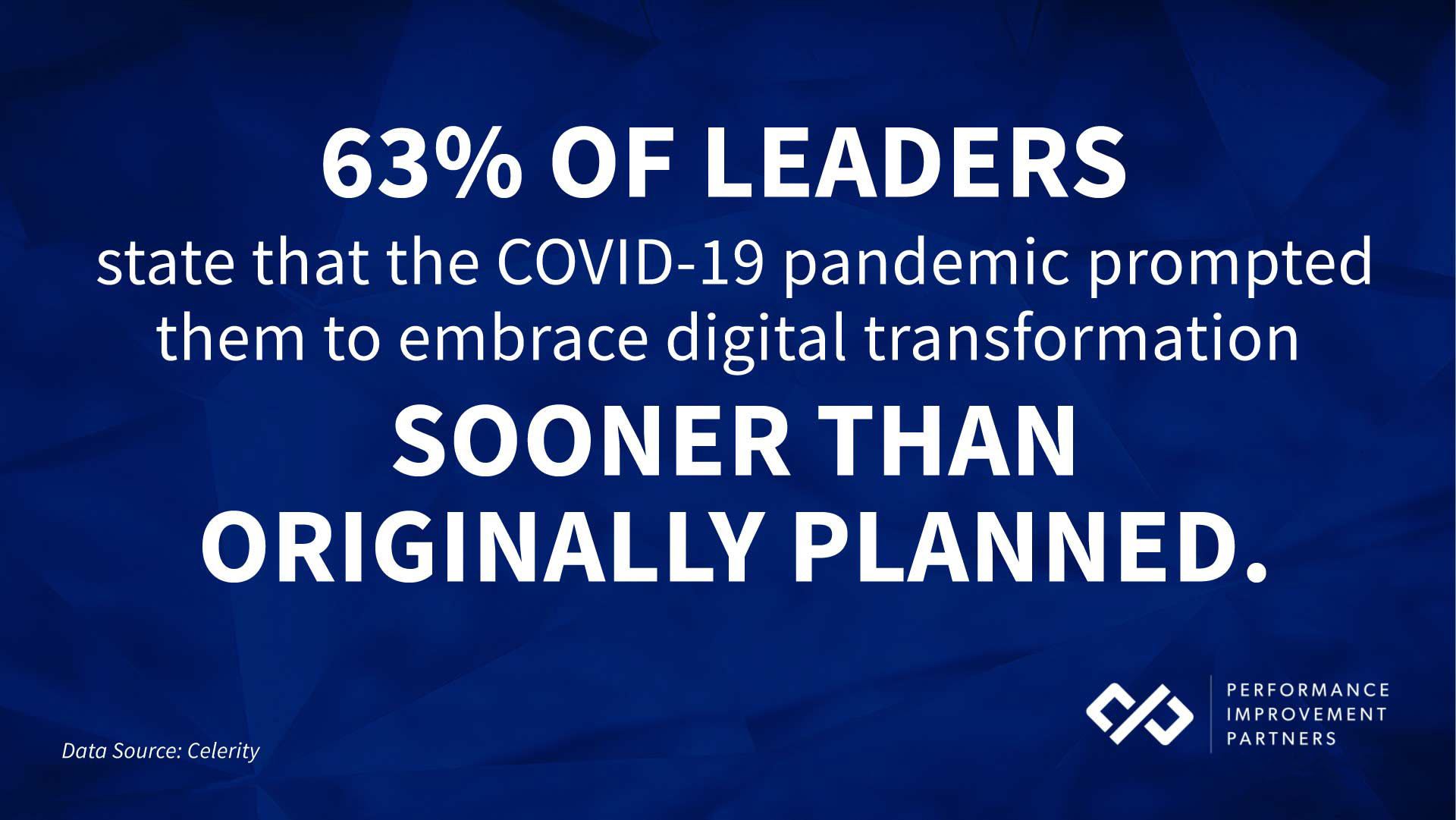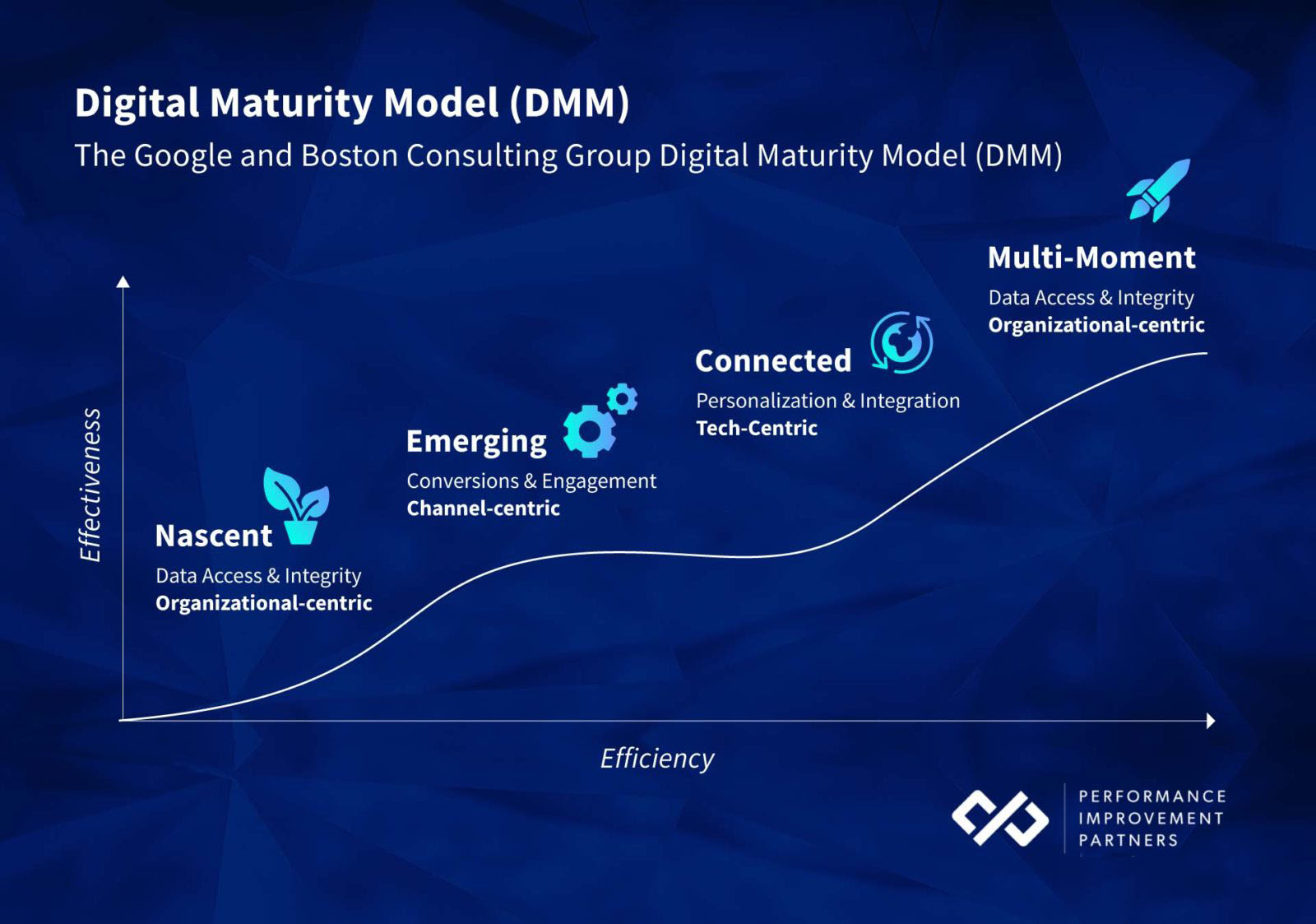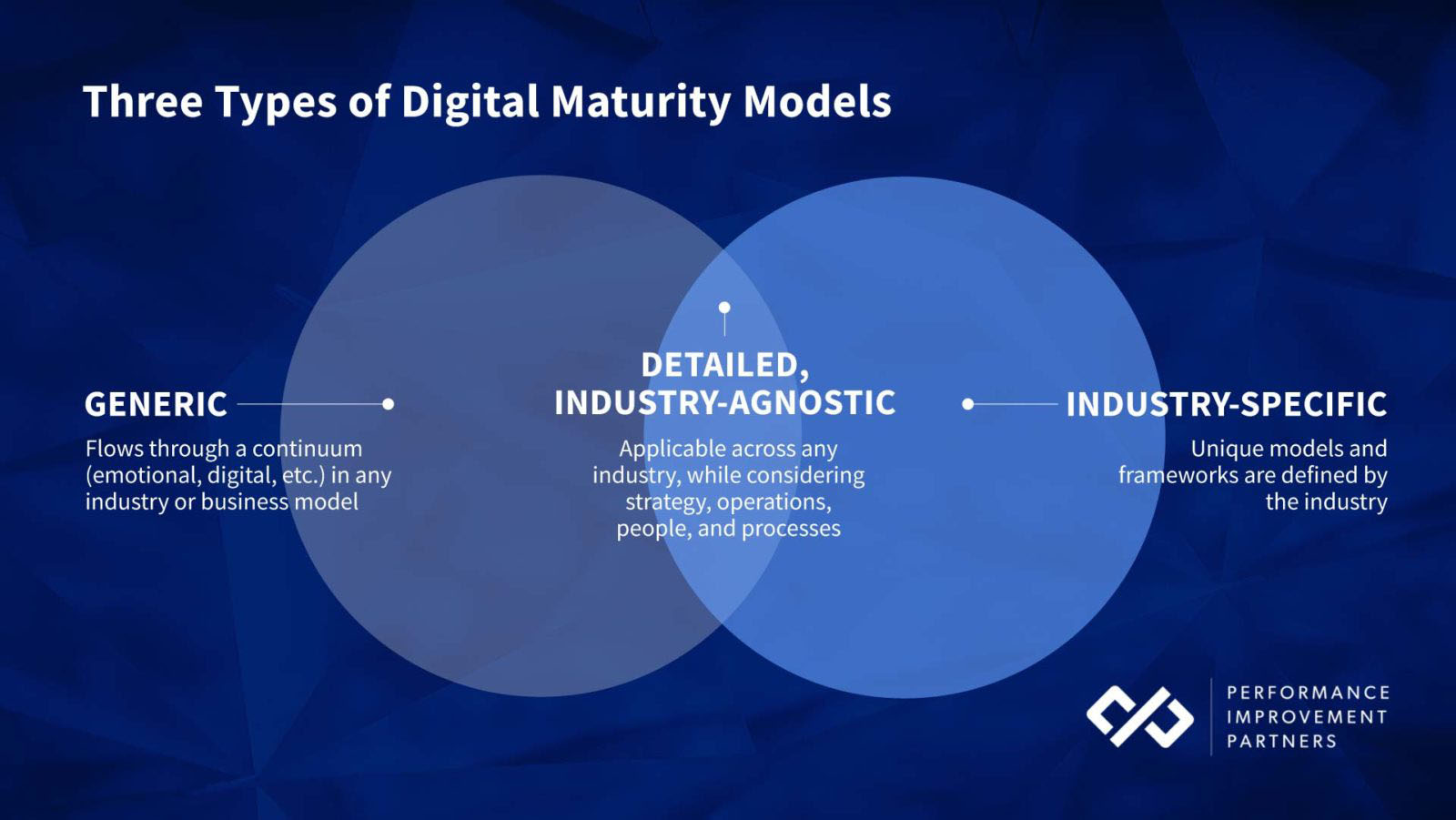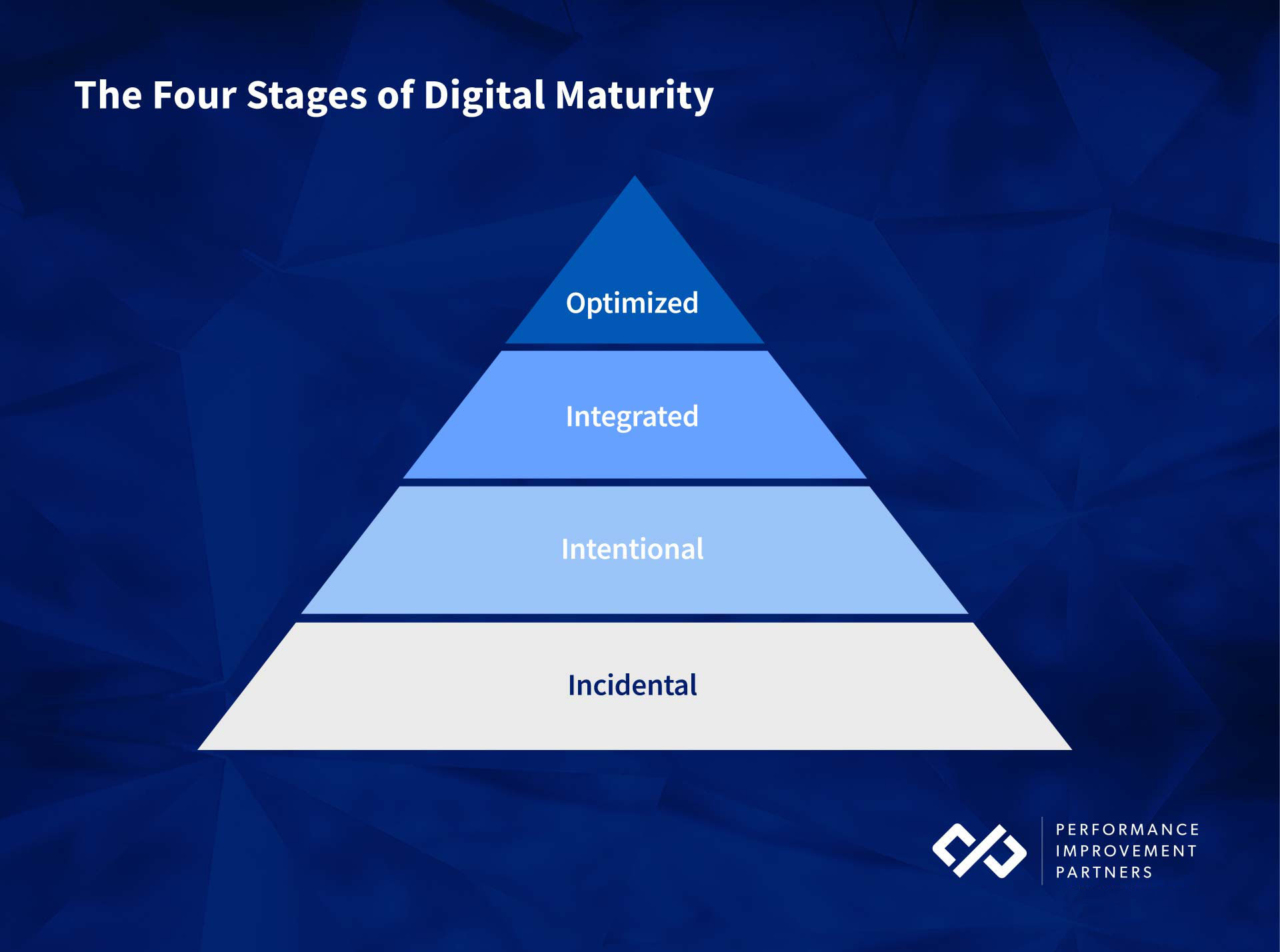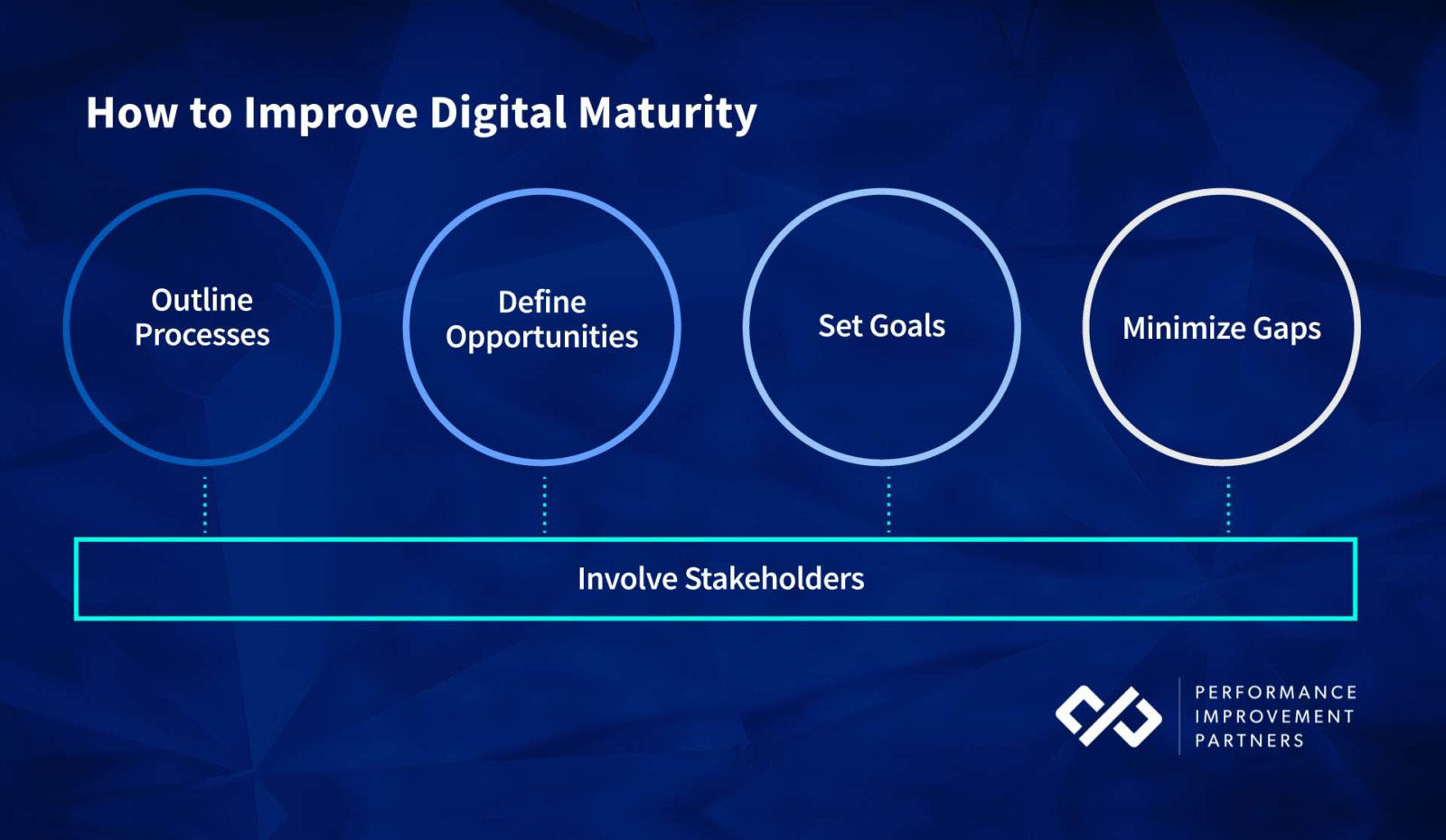Before you learn to run, you must learn to walk. Before you take leaps in business, you must evaluate where you are today.
Digital technologies are no different.
Understanding your company’s digital maturity is the first step in driving value – and profitable business transformation — through digital technologies. Without understanding your current state, and putting a plan in place, you risk making high-cost, low-value decisions or investing in initiatives that your existing technology can’t support.
Defining Digital Maturity
As Dave Rutkowski, CEO of Performance Improvement Partners states, “Digital maturity is the ability to quickly respond to or take advantage of opportunities in the market based on current tech stacks, staffing resources, and digital technology. It’s an organization’s ability to take on digital transformation not only from the standpoint of digital technology, but organization-wide, including people, culture, and processes, to achieve business outcomes.”
While there is a heavy emphasis on technology, the level of digital maturity an organization has is also impacted by speed and adaptability, largely due to resources in human capital and automated processes. It’s a team effort, in the truest sense.
“Digital maturity is the ability to quickly respond to or take advantage of opportunities in the market based on current tech stacks, staffing resources, and digital technology. It’s an organization’s ability to take on digital transformation not only from the standpoint of digital technology, but organization-wide, including people, culture, and processes, to achieve business outcomes.”
— Dave Rutkowski, CEO, Performance Improvement Partners
The Importance of Digital Maturity for Business Growth
The COVID-19 pandemic prompted leaders to embrace digital transformations sooner than expected, resulting in the implementation of digital technologies at a pace never before seen. This is demonstrated by these digital transformation statistics,
- 63% of leaders state that they embraced digital transformation sooner than originally planned due to the COVID-19 pandemic.
- 85% of executives said their businesses have somewhat or greatly accelerated the implementation of technologies that digital enable employee interaction and collaboration since the start of COVID-19—weeks instead of typical months or years.
- 97% of global IT directors said their companies went through digital transformation due to COVID with 60% of them stating the transformation was a “large amount of change.”
To make these rapid digital transformations, companies with a high baseline of digital maturity were able to adapt better and faster, giving them a competitive advantage.
Deloitte reports 43% of highly digital mature companies see significantly higher net profits than their industry averages.
When gauging digital maturity initiatives, it is important to remember — digital maturity itself is not the goal; rather, it is a means to an end.
Consider the following characteristics of digital maturity:
- Access
- Automation
- Customer-centricity
- Efficiency
- Flexibility
- Innovation
- Operational efficacy
- Insight
- Quality
From increased efficiency to improved quality, digital maturity drives outcomes that fuel business growth.
The impact of digital maturity on digital transformation
Digital transformation is the act of physically changing workflows and processes through digital technologies. This means your digital maturity is the degree to which you understand — and have the ability to implement — these changes.
As Rutkowski states, “Digital transformation is a set of actions; digital maturity is a characteristic of your organization versus the actions you’re going to take.”
While not the same thing, digital transformation and digital maturity are inter-related, and both have implications on business operations and efficiencies.
Trying to move forward with digital transformation without understanding your digital maturity level results in unanticipated roadblocks that can derail your operations, leading to lost time and money. Alternatively, creating a digital maturity model without data-driven insights, or a pulse on manual versus digital processes, makes it hard to assess which areas are most critical in driving transformational change.
Trying to move forward with digital transformation without understanding your digital maturity level results in unanticipated roadblocks that can derail your operations, leading to lost time and money.
Following the pandemic, digital transformation – and the resulting business opportunities – will only continue to evolve.
As a result, digital maturity is more important than ever. We have seen a shift of giant proportions in the global economy, in the way customers expect companies to do business, and in the need to employ digital solutions to sustain organizations.
Understanding Digital Maturity Models (DMMs)
A digital maturity model (DMM) is a framework used to assess and understand a company’s current level of digital maturity. The model also provides a roadmap to reach digital maturity goals, plan for growth, and measure success.
There are many DMMs to choose from, but they all provide you with data-driven insight around current levels of digital maturity.
One company may employ a digital maturity model around sales and marketing, another may adopt a DMM model focused on service management, and yet another around IT services.
One of the most popular digital maturity models was produced by Google and the Boston Consulting Group; it focuses primarily on data and how central it is to achieving digital maturity.
This model highlights four stages of digital maturity: Nascent, Emerging, Connected, and Multi-Moment.
1. Nascent
Uses data quality to connect data silos between departments, and requires strong leadership buy-in and stakeholder engagement.
2. Emerging
Focused on improving experiences, deploying new technology, and developing strategies to scale between departments.
3. Connected
Uses data-driven processes to improve productivity, employing offline and online data to drive sales and support common goals across the company.
4. Multi-Moment
Utilizes fully data-driven integrations; optimizing across all channels, touchpoints, and departments.
Rutkowski’s advice when choosing a digital maturity model is to ask yourself, “What do we want to do with our digital maturity model – how do we plan to use it?”
Overall, he sees digital maturity models falling into three categories, ranging from generic to industry-specific.
1. Generic
This model flows through a continuum of maturity (emotional, digital, etc.). Much like Maslow’s Hierarchy of Needs, you can apply it to anything.
2. Detailed, Industry-Agnostic
This offers a solution more refined than the generic model, yet agnostic enough to be applied still to any industry. It looks at digital maturity across multiple aspects of the business, including strategy, operations, people, and processes.
3. Industry-Specific
A more specific model of digital maturity, this model is based on an individual industry with unique models or frameworks to support it.
Regardless of which digital maturity model you adopt, it is important that teams and departments collaborate in outlining business challenges while working through solutions and processes together.
Digital maturity model (DMM) development cannot be done in a vacuum. DMMs are used to benchmark, set direction, and provide savings — both time and money.
The Four Stages of Digital Maturity
Digital transformation is a journey, and the path your company takes on that journey depends on your company’s goals and definition of digital maturity. You need a common understanding of where you’ve been and where you plan to go.
Within each digital maturity model, there are multiple stages that act as a framework to guide goals and evaluate success. And, when utilizing a generic digital maturity model, one can compare the stages of digital maturity to Maslow’s Hierarchy of Needs.
In the same way that self-actualization cannot be met without basic, psychological, and self-fulfillment needs being met, an optimal state of digital maturity – which maximizes value-creation and profitability — requires a firm foundation. Justin Grossman, CEO of Meltmedia, defines the four levels of digital maturity as follows:
1. Incidental: The Need for a Strong Foundation
Activities supporting digital maturity are done by happenstance and are not planned or strategic in nature.
2. Intentional: Building a Digital Strategy
There is purpose and strategy behind digital transformation activities but only in some, not all, areas of business. Many times, these processes are not yet automated.
3. Integrated: Streamlined Digital Transformation Efforts Supported by Leadership
Companies operating at this level are successfully integrating digital transformation strategies across multiple areas of business in a streamlined fashion with buy-in from leadership.
4. Optimized: The Peak of Digital Maturity
The cream of the crop, these companies are fully integrated in digital transformation making it a part of company culture. They can turn on a dime when the market shifts.
When comparing these stages to Maslow’s Hierarchy of needs, it becomes evident that an optimized state of digital maturity cannot be achieved without a proper foundation built on stakeholder support and up-to-date technology.
How to Assess and Improve Digital Maturity
Rutkowski recommends choosing a framework with a pragmatic approach that supports your goals, and that you can benchmark your digital maturity against.
He explains, “This will look different depending on your objectives. Assess where you are today and determine what your target or landing point is; use that as another boundary condition. Where do you currently sit on the continuum, and where do you want to be? What are the outcomes you want to achieve?
To understand where you are on the continuum, and achieve optimal outcomes from digital technologies, the path towards digital maturity begins with an IT roadmap.
The roadmap will bring to fruition where your current state of digital maturity lies, and uncover which gaps are most imperative to address.
Tools commonly used to drive business value, such as cloud technologies and automation, require an IT infrastructure that can support these systems. In addition, it’s important to note: The further you go into digital technologies, the higher the cybersecurity risks to your business: Cybersecurity must be a part of your plan from day one.
From there, focus on the gaps to fine-tune and improve your maturity levels. Outline processes, define your opportunities, goals, and strategies to minimize the gaps, and define key processes needed to move through your digital transformation journey.
Talk with stakeholders in the company about the current processes of integrating new technologies for efficient workflows. Analyze current digital tactics and the wish list of those that would make output, customer interaction, teams automated, streamlined and more efficient. Dig deeper into current tactics for a true sense of whether they are giving you a competitive advantage.
As Rutkowski reminds us, “Digital maturity is a spectrum. It’s not black and white; there are all kinds of shades of gray. There is no right answer of how digitally mature you should be.”
Increase Digital Maturity, Increase Value
The ability to quickly adapt and respond to changes in the market—whether you have control over those changes or not—outlines your company’s level of digital maturity.
Likewise, your digital capabilities have a direct effect on operational efficiencies. They can redefine the way you operate. They can expedite new business ventures.
As you evaluate your digital maturity, consider all factors — including the needs of the business, internal and external stakeholders, customers — then develop a digital technology strategy that drives business growth while optimizing spend. You can’t improve what you can’t measure.
The first step is understanding where you are today and building out an IT roadmap on how you want to address these gaps.
Questions about how to lay a firm foundation to build your digital success? Our team of experienced technology experts is happy to help.

